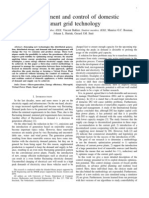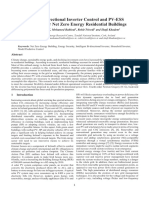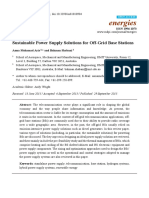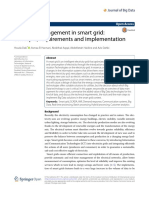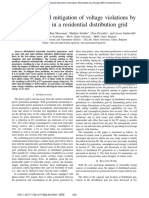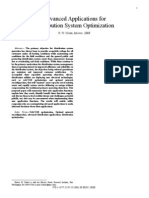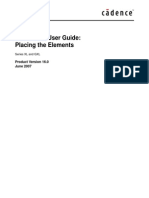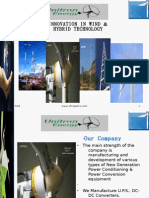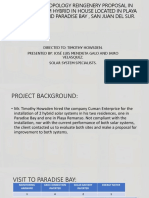0 ratings0% found this document useful (0 votes)
42 viewsEfficient ICT For Efficient Smart Grids
Efficient ICT For Efficient Smart Grids
Uploaded by
a_damrong91
Copyright:
© All Rights Reserved
Available Formats
Download as PDF, TXT or read online from Scribd
Efficient ICT For Efficient Smart Grids
Efficient ICT For Efficient Smart Grids
Uploaded by
a_damrong0 ratings0% found this document useful (0 votes)
42 views3 pages91
Original Title
ISGT2012-000091
Copyright
© © All Rights Reserved
Available Formats
PDF, TXT or read online from Scribd
Share this document
Did you find this document useful?
Is this content inappropriate?
91
Copyright:
© All Rights Reserved
Available Formats
Download as PDF, TXT or read online from Scribd
Download as pdf or txt
0 ratings0% found this document useful (0 votes)
42 views3 pagesEfficient ICT For Efficient Smart Grids
Efficient ICT For Efficient Smart Grids
Uploaded by
a_damrong91
Copyright:
© All Rights Reserved
Available Formats
Download as PDF, TXT or read online from Scribd
Download as pdf or txt
You are on page 1of 3
1
Efcient ICT for efcient Smart Grids
Gerard J.M. Smit, University of Twente, Enschede, the Netherlands
contact: g.j.m.smit@utwente.nl
AbstractIn this extended abstract the need for efcient and
reliable ICT is discussed. Efciency of ICT not only deals
with energy-efcient ICT hardware, but also deals with ef-
cient algorithms, efcient design methods, efcient networking
infrastructures etc. Efcient and reliable ICT is a prerequisite
for efcient Smart Grids. Unfortunately, efciency and reliability
have not always received the proper attention in the ICT domain
in the past.
A. Introduction
Although much of the worldwide increase in electricity
consumption is attributed to ICT, the same ICT technology
can also be used to reduce the worldwide energy consumption.
Efcient ICT systems can, for example, be used to control
the consumption, production, transportation, and storage of
electricity (Smart Grids). Next ICT systems can be used to
control and schedule large electricity consuming and produc-
ing appliances in an optimal way. Therefore, ICT plays a key
role in reducing the energy intensity of the economy, thus
helping to decouple growth from energy consumption and
creating new opportunities while saving the environment.
Research in using ICT for reducing energy consumption
may include issues such as e.g.
exible ICT systems for (decentralized) electricity man-
agement
technologies and tools for dependable ICT systems that
continue to operate when elements fail in the electricity
network (Smart Grids),
versatile multi-purpose energy-efcient ICT systems and
communication infrastructures which can handle a wide
range of (future) services to safeguard sustainability, and
energy-aware systems which integrate real-time infor-
mation from (wireless) sensor networks and external
information sources such as weather forecasts.
In March 2007, the European Council agreed on an ac-
tion plan on European energy policy. This action plan is
known as the EU 20-20-20 plan. It sets new, binding targets
for the reduction of greenhouse gas emissions from energy
consumption. These will be met through increasing the use
of renewables to 20% of total energy consumption by 2020,
mostly via highly decentralized green power generators (like
from wind, biomass, or solar energy; or from micro-CHPs
or energy storage systems) forming Virtual Power Plants.
Furthermore, improving energy efciency should ensure that
the total energy usage is 20% lower than current projections for
G.J.M. Smit is professor of the Computer Architecture for Embedded
Systems (CAES) group within the Department of Electrical Engineering,
Mathematics and Computer Science, University of Twente, P.O. Box 217,
7500 AE, Enschede, The Netherlands
2020, through reduction of consumption and of transmission
losses as well as improvement of energy-conversion efciency.
The energy technologies in use today were mostly designed
for a different era based on centralised energy generation and
economies of scale. Today the energy companies are facing a
transition to address the goals of the new EU energy policy.
This will require new energy and ICT infrastructures. The
driving forces for this transition are the security of energy
supply and environmental concerns. ICT will be an enabler
in this process and will lead to the creation of new energy
markets, decentralized control, and higher system quality,
efciency and reliability.
According to a recent report 2020 [1] of the Climate Group
and McKinsey, ICT is a key player in the battle against climate
change and offers the possibility of 7.8 Gt reduction of CO
2
emission in 2020. A recent annex of this report calculates
a saving of 140-240 billion dollar in the US by reducing
the energy consumption due to smart usage of ICT systems.
Also the European Commission is stressing the importance
of ICT for energy reduction and sustainability and invests
in research in this area [2]. The plans have amongst others
resulted in a number of research programmes combining ICT
with Energy. For example the EU-PPP programme on Energy
Efcient Buildings and the EU-FP7 calls for ICT for Energy
Efciency, ICT for environmental services and climate change
adaptation, novel ICT solutions for Smart Electricity Distribu-
tion Networks, ICT for energy-efcient buildings and spaces
of public use and ICT for energy-positive neighbourhoods.
B. Efcient ICT
Energy consumption is one of the main concerns of todays
ICT hardware and software designers and systems integrators.
Regarding energy-efciency the rst type of devices people
usually think of are portable devices as these devices rely
on batteries and therefore the functionality is strictly limited
by the energy consumption. However, for high performance
computing there is also an increasing need for energy-efcient
architectures to reduce the cost for cooling and packaging.
Today also the performance of many ICT systems is limited
by energy dissipation and electricity supply. In addition to that
there are environmental concerns that urge for more efcient
architectures in particular for systems that run 24/7 (24 hours
per day 7 days per week) such as wireless base stations,
servers parks, data centres and search engines (e.g. Google
has an estimated server park of one million servers that run
24/7). Energy reduction can be done at several layers: reduce
energy for processing and storage of data, reduce energy for
communication, operating systems and software.
One important aspect in energy reduction is locality of
reference. This means that data that a processing element
978-1-4577-2159-5/12/$31.00 2011 IEEE
2
frequently needs should be located close to the processing
element. For example it is quite inefcient when sensor data is
brought to a central location, where the processing is done and
brought back to the actuators, that are often located close to
the sensors, where actuation is done. When wireless networks
are needed to transport this data, often more energy is spent
in data communication compared to the energy in the central
processing. This means that processing should be done close to
sensors whenever possible. In our opinion the cloud computing
paradigm is less applicable for Smart Grids, because data is
distributed over many devices scattered over a large area and
the processing is rather simple. However, cloud computing
can be used for high-level control and optimisation of energy
streams.
C. Energy Management
In a few years from now a large percentage of the electricity
will be generated by decentralized micro-generators, (e.g.
micro-CHPs and solar cells). Micro generation systems gener-
ate electricity at the kilowatt level which will allow the units
to be installed in an individual home and connected directly
with the domestic heating and electrical systems, which by
denition entails very high efciency (up to 90%) in usage of
primary energy. Also, it allows for delivery of electricity to the
power grid, where the distance to its consumer may be limited,
e.g. in the same city or neighbourhood. The micro-generation
concept has the additional benet of reduced distribution and
transmission losses, delivering signicant advantages in terms
of overall efciency relative to centrally generated power. This
concept offers an attractive option in the reduction of primary
energy consumption and therefore carbon (CO
2
) emissions.
On the long run we will rely on renewable energies.
Renewable energies are generally based on a large number
of even smaller sources of power, producing power much
closer to the location in which it is used. Some installations,
such as those producing heat, can only supply users in their
immediate area, while equipment which produces electricity,
such as windmills, biomass systems, or photovoltaic roof
panels, can be used to supply to electricity networks.
The introduction of renewable energy requires the develop-
ment of new ICT systems for obtaining energy efciency and
meeting grid requirements, while maintaining high standards
of comfort, quality and reliability of services as well as
connectivity. In addition, the future availability of storage
devices (such as batteries in electric cars) opens up new
perspectives and constraints, both from the sides of storage and
supply (to the grid), as well as demand (from the grid). The
demand for electricity in a large network varies dynamically as
millions of users continuously switch on and off independently
their equipment. The wholesale price of electricity, paid by
distributors to (large scale) generators, also rises and falls
with demand. A similar approach could be applied to massive
amounts of small-scale generators, seen as a Virtual Power
Plant (VPP).
An intelligent system employed by the operator of a small-
scale generation resource, such as photovoltaic panels on a
house, or a fuel-cell, would be able to recognise when surplus
energy can best be sold on the market, and when it should be
used to heat water, for example. Similarly, continuous agree-
ments for supplies during short or long durations, involving
e.g. prices, timing, and quantities could be made between
network operators and small-scale suppliers.
ICT provides the means to manage the operation of mil-
lions of small-scale electricity generation appliances, both
on behalf of their owners and for the networks into which
they feed. ICT tools can monitor a range of variables and
ensure that both individuals and the network as a whole
gain maximum efciency from the energy generation capacity
available. Development of such ICT systems will therefore fuel
the installation of new and renewable-energy-based generation
capacity, through maximising the return on investment so
making it more affordable. In this way, it can more quickly
meet its goals in the eld of stable electricity supply, energy
efciency and emissions reduction, and provide consumers
with higher quality energy supplies.
The electricity grid has to cope with the variability of the
future generators and consumers, many of which are still
unknown. In principle, the smart grid is an upgrade of 20th
century power grids, which generally broadcast power from
a few central power generators to a large number of users, to
instead be capable of routing power in more optimal ways to
respond to a very wide range of conditions. The conditions,
to which a smart grid can respond, may occur anywhere in
the power generation, distribution and demand chain. Events
may occur generally in the environment (clouds blocking the
sun and reducing the amount of solar power, a very hot
day), commercially in the power supply market (prices to
meet a high peak demand exceeding one dollar per kilowatt-
hour), locally on the distribution grid (MV transformer failures
requiring a temporary shutdown of one distribution line) or in
the home (someone leaving for work, putting various devices
into hibernation), which motivate a change to its power ow.
In addition, several constraints are induced by the power grid
itself as well as the devices connected to it.
One of the problems Smart Grids are facing with is that not
all decentralized micro-generation systems have predictable
electricity generation patterns. For example solar cells are
dependent on the time of the day and the amount of sunlight.
Wind energy is only available when there is wind and micro-
CHP systems only produce electricity when there is a heat
demand. As a consequence, decentralized systems sometimes
produce electricity when there is no need for it locally.
A solution to these problems may be to transform domestic
customers from static consumers into active participants in the
production process. Consumer participation can be achieved
through the development of new (domestic) devices with con-
trollable load, micro-generation and domestic energy storage
of both heat and electricity. These devices have potential
to shift electricity consumption in time without harming the
comfort of the residents.
D. 3 step control methodology
Examples of devices with optimization potential are (smart)
freezers and fridges, which can adjust their cooling cycles to
3
shift their electricity load and (electrical car) batteries that can
temporarily store excess electricity. To exploit this optimiza-
tion potential on a large scale, a global control methodology is
required [3]. The above-mentioned challenges and optimiza-
tion potential are studied and a control methodology is derived.
This control methodology aims:
to achieve a more efcient use of the generated electricity
of existing power plants,
to facilitate the large scale introduction of renewable
sources and
to allow large scale introduction of new technologies for
production, consumption and storage while at the same
time maintaining grid stability and ensuring a reliable and
affordable supply.
The control methodology uses mathematical optimization
techniques and a combination of prediction, ofine global
planning based on the predictions and online realtime con-
trol based on the global planning. The base of the control
methodology is:
using local information,
communication using multiple levels and
scalability.
The goal of the control methodology is to work towards
(global) objectives and the performance of the control method-
ology is measured to the extent to which the objectives are
reached. Based on the above considerations, the proposed
control methodology uses three steps and is split up into a
local and a global part:
1) predictions on a device level to be able to predict the
overall result,
2) planning to estimate the energy streams in the building
and the grid and
3) real-time control to respond on changes (e.g. uctuations
in renewable generation) and work around predictions
errors.
In the rst step, the energy usage or production for every
individual building in the grid is predicted on a device level.
In the second step, the predictions of the individual buildings
are aggregated and a global planning is made in an iterative
and hierarchical way. The result of this planning is an energy
prole. In the last step, a local scheduler in every building
schedules the devices in real-time, using steering signals
determined by the global planning as an input.
Because of scalability reasons, the global planning has a
hierarchical structure and can aggregate data and planning on
different levels, e.g. within a neighbourhood or city. The level
on which the planning is determined and, thus, the highest
level of the global controller determines the scope (e.g. a local
scope or a neighbourhood scope). Especially the three steps
and the global planning differ from the control methodologies
described in literature. Furthermore, the control methodology
is not agent based and uses other mathematical optimization
methods or heuristics than the control methodologies described
above.
Due to the predictions and planning on beforehand, the
predictability of the global electricity streams is improved.
The combination of planning (aggregated knowledge on higher
levels) and mathematical optimization result in better depend-
ability and combination of planning and real-time control
improves the control over unexpected events. Furthermore,
the amount of communication can be limited due to the
hierarchical structure. Finally, the requirements on the com-
munication medium are low since the local controller can
work independently and a lot of information can be sent on
beforehand without high latency requirements.
Simulations show that the control methodology can optimize
the energy ows and can control the operation of the domestic
devices in an economic manner without discomfort for the
residents. The prediction and planning step preceding the real-
time control improves the results of the control methodology:
much more optimization potential can be exploited and the
results are more predictable and dependable.
The challenging issues on the non-technical side include
regulatory regimes, business models, user psychology (includ-
ing awareness) and privacy, governance and social dynamics.
Widespread distributed generation requires completely new
regulation since the traditional roles of producers and con-
sumers are about to change. For the same reason, new business
models are needed. It might intervene quite substantially in the
daily energy routines of households with severe consequences
for routines and privacy. Finally, it might initiate new social
communities with new functions and activities. Some chal-
lenges are:
Behaviour of end-users
Privacy and data protection
Economics and transactions: who pays for what
Legislation and regulation issues
E. Conclusion
ICT provides the enabling technology to realise the EU
20-20-20 goals. The energy technologies in use today were
mostly designed for a different era based on centralised energy
generation and economies of scale. Today we are facing a
transition to address the goals of the new EU energy policy.
This will require new energy and ICT infrastructures. The
driving forces for this transition are the security of energy
supply and environmental concerns. ICT will lead to the
creation of new energy markets, decentralized control, and
higher system quality, efciency and reliability. An important
aspect is that for future energy systems prediction and planning
is required.
REFERENCES
[1] The Climate Group, Global e-Sustainability Initiative (GeSI), Smart
2020: Enabling the low carbon economy in the information age, 2008,
http://www.smart2020.org/.
[2] Commission of the European Communities, Mobilising ict to facilitate
the transition to an energy-efcient, low-carbon economy, 2009.
[3] A. Molderink, V. Bakker, M. G. C. Bosman, J. L. Hurink, and G. J. M.
Smit, Management and control of domestic smart grid technology, IEEE
Transactions on Smart Grid, vol. 1, no. 2, pp. 109119, 2010.
You might also like
- PHD Research Proposal (Electrical Power & Energy Engineering) PDFDocument13 pagesPHD Research Proposal (Electrical Power & Energy Engineering) PDFSaraMuzaffar33% (3)
- Project Report On Smart GridDocument47 pagesProject Report On Smart GridRajnish Chandra Prasad87% (71)
- ICT For Green - How Computers Can Help Us To Conserve EnergyDocument10 pagesICT For Green - How Computers Can Help Us To Conserve EnergyCamille Barcebal PastranaNo ratings yet
- Smart Grid12 09Document11 pagesSmart Grid12 09Akshatha NaikNo ratings yet
- Shsconf Ifsdr2021 02005Document8 pagesShsconf Ifsdr2021 02005cloydsolis0No ratings yet
- Smart Grids: Under The Esteem Guidance of MR - Srinath SirDocument7 pagesSmart Grids: Under The Esteem Guidance of MR - Srinath SirSubhashini Pulathota0% (1)
- Full Report On "VEHICLE TO GRID TECHNOLOGY (V2G) "Document35 pagesFull Report On "VEHICLE TO GRID TECHNOLOGY (V2G) "Rahul Garg67% (3)
- Europe: Impact of Dispersed and Renewable Generation On Power System StructureDocument38 pagesEurope: Impact of Dispersed and Renewable Generation On Power System StructuredanielraqueNo ratings yet
- Energies: Buildings Energy Efficiency Analysis and Classification Using Various Machine Learning Technique ClassifiersDocument24 pagesEnergies: Buildings Energy Efficiency Analysis and Classification Using Various Machine Learning Technique ClassifiersIramfatimaNo ratings yet
- Understanding The Role of Buildings in A Smart Microgrid: Yuvraj Agarwal Thomas Weng Rajesh K. GuptaDocument6 pagesUnderstanding The Role of Buildings in A Smart Microgrid: Yuvraj Agarwal Thomas Weng Rajesh K. GuptanavidelecNo ratings yet
- Smart GridDocument10 pagesSmart GridAnand SreekumarNo ratings yet
- The Utility of The Future WPDocument4 pagesThe Utility of The Future WPbartee000No ratings yet
- An Innovative Approach For Forecasting of Energy Requirements To Improve A Smart Home Management System Based On BLEDocument9 pagesAn Innovative Approach For Forecasting of Energy Requirements To Improve A Smart Home Management System Based On BLEVIKRAM K 14PHD0358No ratings yet
- Energy Management Concepts For The Evolution of Smart GridsDocument6 pagesEnergy Management Concepts For The Evolution of Smart GridsManeesh Kumar GuptaNo ratings yet
- Micro Grids by LasseterDocument8 pagesMicro Grids by LasseterNikhil PerlaNo ratings yet
- Energy Efficiency in NetworkingDocument14 pagesEnergy Efficiency in Networkinggustavodeser19831No ratings yet
- Smart Bi-Directional Inverter Control and PV-ESS Integration For Net Zero Energy Residential BuildingsDocument6 pagesSmart Bi-Directional Inverter Control and PV-ESS Integration For Net Zero Energy Residential Buildingsadithyakrishnan00007No ratings yet
- Management and Control of Domestic Smart Grid TechnologyDocument11 pagesManagement and Control of Domestic Smart Grid TechnologyJunaid AhmedNo ratings yet
- Energy Efficiency in Telecommunication Network - Energy Consuption Saving and Renewable SourcesDocument10 pagesEnergy Efficiency in Telecommunication Network - Energy Consuption Saving and Renewable SourcesMuharemNo ratings yet
- State of The Art in Distribution Network OperationsDocument3 pagesState of The Art in Distribution Network OperationsAWe SyamroniNo ratings yet
- Unit 2Document24 pagesUnit 2Omkar Shete100% (1)
- Energy MonitoringDocument28 pagesEnergy MonitoringHazim SanusiNo ratings yet
- ECPE-Position Paper Energy EfficiencyDocument18 pagesECPE-Position Paper Energy EfficiencyMarcWorldNo ratings yet
- 38,202 - Renewable ProjectDocument40 pages38,202 - Renewable ProjectAnas AyubNo ratings yet
- Smart TelecomDocument4 pagesSmart TelecomPerez Wa MugohaNo ratings yet
- Energy Efficient On Hybrid Self-Powered Mobile Towers Based On IoTDocument21 pagesEnergy Efficient On Hybrid Self-Powered Mobile Towers Based On IoTCentral Asian StudiesNo ratings yet
- 2010 Jul Smart GridsDocument0 pages2010 Jul Smart GridshafizgNo ratings yet
- Intelligent World 2030 Digitalization Trends in The Electric Power IndustryDocument66 pagesIntelligent World 2030 Digitalization Trends in The Electric Power Industrytiberiu_stefanNo ratings yet
- Data Analytics in Smart BuildingsDocument39 pagesData Analytics in Smart BuildingsPeter WUNo ratings yet
- Ijeet: International Journal of Electrical Engineering & Technology (Ijeet)Document11 pagesIjeet: International Journal of Electrical Engineering & Technology (Ijeet)IAEME PublicationNo ratings yet
- Smart Grid Technology Nciaee 002Document8 pagesSmart Grid Technology Nciaee 002Mayank YadavNo ratings yet
- Smart GridDocument20 pagesSmart GridPrabir Kumar PatiNo ratings yet
- Urban Microgrids Public Report - VF3 PDFDocument55 pagesUrban Microgrids Public Report - VF3 PDFFazila KhanNo ratings yet
- Energies 13 06546 v2Document19 pagesEnergies 13 06546 v2Francesco TedescoNo ratings yet
- Electricity Consumption and Generation Forecasting With Artificial Neural NetworksDocument22 pagesElectricity Consumption and Generation Forecasting With Artificial Neural Networksjerrymcguire2024No ratings yet
- Smart GridDocument24 pagesSmart GridAbhinav AithalNo ratings yet
- Energies: Stochastic Modeling and Optimization in A Microgrid: A SurveyDocument24 pagesEnergies: Stochastic Modeling and Optimization in A Microgrid: A Surveyzabiruddin786No ratings yet
- Research Action Plane For Doctoral StudyDocument16 pagesResearch Action Plane For Doctoral StudyGetie Tesfaye ZelieNo ratings yet
- Development of Smart Grid Interoperability For Energy Efficiency SystemsDocument28 pagesDevelopment of Smart Grid Interoperability For Energy Efficiency SystemsEditor IJTSRDNo ratings yet
- Thesis Paper On Smart GridDocument7 pagesThesis Paper On Smart Gridshannonsandbillings100% (2)
- Energies: Sustainable Power Supply Solutions For Off-Grid Base StationsDocument38 pagesEnergies: Sustainable Power Supply Solutions For Off-Grid Base StationsHenrique MartinsNo ratings yet
- Report On Smart GridsDocument16 pagesReport On Smart GridsTeja Dhft NtrNo ratings yet
- Distributed Generation in Developing CountriesDocument12 pagesDistributed Generation in Developing CountriesSaud PakpahanNo ratings yet
- On The Communication Requirements For The Smart Grid: Mohamed Daoud, Xavier FernandoDocument8 pagesOn The Communication Requirements For The Smart Grid: Mohamed Daoud, Xavier Fernandoellie210879No ratings yet
- Towards Efficient Energy Management in Smart Grids Considering Microgrids With Day-Ahead Energy ForecastingDocument11 pagesTowards Efficient Energy Management in Smart Grids Considering Microgrids With Day-Ahead Energy ForecastingYahaya FatawuNo ratings yet
- Grid of The Future: Are We Ready To Transition To A Smart Grid?Document11 pagesGrid of The Future: Are We Ready To Transition To A Smart Grid?XavimVXSNo ratings yet
- FTTO TechnologyDocument20 pagesFTTO TechnologyMajda KaradzaNo ratings yet
- Innovative Power Distribution For Hospitals PDFDocument26 pagesInnovative Power Distribution For Hospitals PDFQuophi Click LyfttedNo ratings yet
- Why Smart Grid Is EssentialDocument7 pagesWhy Smart Grid Is Essentialkaushik4endNo ratings yet
- BITCON - Paper - Final Feb18 1Document6 pagesBITCON - Paper - Final Feb18 1Bhalchandra MurariNo ratings yet
- Conceptual Studyon Renewable Energy and Electric Vehicle Integration in Smart GridsDocument9 pagesConceptual Studyon Renewable Energy and Electric Vehicle Integration in Smart GridsOgwugwuam EzeagwuNo ratings yet
- Daki2017 Article BigDataManagementInSmartGridCoDocument19 pagesDaki2017 Article BigDataManagementInSmartGridColeo rajuNo ratings yet
- Smart Grid ProposalDocument5 pagesSmart Grid Proposalali farooqNo ratings yet
- INSE 6640 ProjectDocument14 pagesINSE 6640 Projectvitodi1844No ratings yet
- An Intelligent Load Management System With Renewable Energy Integration For Smart HomesDocument14 pagesAn Intelligent Load Management System With Renewable Energy Integration For Smart HomesektNo ratings yet
- Term Project Report: Big Data and Smart Grid: Scope For Indian Power SectorDocument14 pagesTerm Project Report: Big Data and Smart Grid: Scope For Indian Power SectorAvani PatelNo ratings yet
- Verschueren 2011Document6 pagesVerschueren 2011Simo MilenkovićNo ratings yet
- Electric Energy Management in Residential Areas Through Coordination of Multiple Smart HomesDocument16 pagesElectric Energy Management in Residential Areas Through Coordination of Multiple Smart HomesalirezaNo ratings yet
- EU China Energy Magazine 2022 March Issue: 2022, #2From EverandEU China Energy Magazine 2022 March Issue: 2022, #2No ratings yet
- Building Resilient Infrastructures For Smart Energy Systems (Abstract)Document1 pageBuilding Resilient Infrastructures For Smart Energy Systems (Abstract)a_damrongNo ratings yet
- Isgt2012 000102Document1 pageIsgt2012 000102a_damrongNo ratings yet
- White Paper: What Your Smart Grid Needs From A Power Management SystemDocument8 pagesWhite Paper: What Your Smart Grid Needs From A Power Management Systema_damrongNo ratings yet
- Queuing Models For Providing Quality of Service To Transactive LoadsDocument1 pageQueuing Models For Providing Quality of Service To Transactive Loadsa_damrongNo ratings yet
- Allegro PCB Si Sigxplorer L Series Tutorial: Product Version 15.7 July 2006Document48 pagesAllegro PCB Si Sigxplorer L Series Tutorial: Product Version 15.7 July 2006a_damrongNo ratings yet
- Verifying Interoperability and Application Performance of Pmus and Pmu-Enabled Ieds at The Device and System LevelDocument3 pagesVerifying Interoperability and Application Performance of Pmus and Pmu-Enabled Ieds at The Device and System Levela_damrongNo ratings yet
- Isgt2012 000082Document1 pageIsgt2012 000082a_damrongNo ratings yet
- Al Gro StartDocument183 pagesAl Gro Starta_damrongNo ratings yet
- Advanced Applications For Distribution System Optimization: R. W. Uluski, Member, IEEEDocument1 pageAdvanced Applications For Distribution System Optimization: R. W. Uluski, Member, IEEEa_damrongNo ratings yet
- Al Gro TutorialDocument10 pagesAl Gro Tutoriala_damrongNo ratings yet
- Al Gro ShapesDocument42 pagesAl Gro Shapesa_damrongNo ratings yet
- Al Gro PlaceDocument100 pagesAl Gro Placea_damrongNo ratings yet
- Al Gro Back DrillDocument30 pagesAl Gro Back Drilla_damrongNo ratings yet
- Allegro PCB Editor User Guide: Preparing Manufacturing Data: Product Version 16.0 June 2007Document132 pagesAllegro PCB Editor User Guide: Preparing Manufacturing Data: Product Version 16.0 June 2007a_damrongNo ratings yet
- Al Gro RouteDocument148 pagesAl Gro Routea_damrongNo ratings yet
- Best Practices: Working With IDF: Product Version 16.0 June 2007Document40 pagesBest Practices: Working With IDF: Product Version 16.0 June 2007a_damrongNo ratings yet
- A Dvanced A Nalysis Library List Pspice: R Elease 16.0 C Opyright © 2000-2007 C Adence D Esign System S, IncDocument247 pagesA Dvanced A Nalysis Library List Pspice: R Elease 16.0 C Opyright © 2000-2007 C Adence D Esign System S, Inca_damrongNo ratings yet
- Allegro PCB Editor User Guide: Creating Design Rules: Product Version 16.0 June 2007Document46 pagesAllegro PCB Editor User Guide: Creating Design Rules: Product Version 16.0 June 2007a_damrongNo ratings yet
- Alg Rodes CMPDocument108 pagesAlg Rodes CMPa_damrongNo ratings yet
- Flex Net End User GuideDocument166 pagesFlex Net End User GuideKGtechSistema]sNo ratings yet
- ReadmeDocument1 pageReadmea_damrongNo ratings yet
- PVL Racing Ignition 1Document8 pagesPVL Racing Ignition 1GabrielCaravana100% (1)
- Catalogo 21 - Howell BungerDocument8 pagesCatalogo 21 - Howell Bungermfmechanics100% (1)
- Bodi - (Power Plant Economics) (170718)Document20 pagesBodi - (Power Plant Economics) (170718)Fahel Bin Noor100% (1)
- Unit RonDocument59 pagesUnit Ronnogard999No ratings yet
- Electrical Thumb Rules You MUST Follow Part 2Document2 pagesElectrical Thumb Rules You MUST Follow Part 2shaikhsajid242No ratings yet
- An Overview of Hybrid Electric Vehicle Technology: Omonowo D. Momoh Michael O. OmoiguiDocument7 pagesAn Overview of Hybrid Electric Vehicle Technology: Omonowo D. Momoh Michael O. OmoiguiSidahmed LarbaouiNo ratings yet
- Aurora Regenerative Turbine 150 Series BrochureDocument8 pagesAurora Regenerative Turbine 150 Series Brochurethehammer2No ratings yet
- (Solutions) Kittel - Introduction To Solid State Physics 8Th EditionDocument60 pages(Solutions) Kittel - Introduction To Solid State Physics 8Th EditionCody Foster0% (1)
- Hydro Nepal Vol I Issue 2Document34 pagesHydro Nepal Vol I Issue 2Razn NhemaphukiNo ratings yet
- Sheet5 (Marine) - 1Document2 pagesSheet5 (Marine) - 1AhmedTahaNo ratings yet
- Goldman Sachs Report 2023 - Carbon CreditsDocument30 pagesGoldman Sachs Report 2023 - Carbon CreditsNitin AgrawalNo ratings yet
- Nickel-Iron Batteries (Edison Cell)Document8 pagesNickel-Iron Batteries (Edison Cell)Centaur ArcherNo ratings yet
- M Tech I Sem II Mid TDDocument4 pagesM Tech I Sem II Mid TDMir Mustafa AliNo ratings yet
- Protection Coordination in NetworksDocument100 pagesProtection Coordination in NetworksZoki100% (1)
- Resort Literature StudyDocument11 pagesResort Literature StudySoundar Rajan85% (33)
- PGCB Job PreparationDocument25 pagesPGCB Job PreparationShamim MollaNo ratings yet
- Table A - 1: 910 ThermodynamicsDocument36 pagesTable A - 1: 910 ThermodynamicsLivia MauriNo ratings yet
- REPDF AllDocument267 pagesREPDF AllSHYAM KRISHNANo ratings yet
- IEC61683 Efficiency CertificateDocument20 pagesIEC61683 Efficiency CertificatearunghandwalNo ratings yet
- KOM AnimationDocument54 pagesKOM Animationnagarajan224No ratings yet
- Assessment Report On The Electrical Pump BreakdownsDocument22 pagesAssessment Report On The Electrical Pump BreakdownsEdwin Cob GuriNo ratings yet
- HOSHIZAKI KM1200 SWE All Models PDFDocument141 pagesHOSHIZAKI KM1200 SWE All Models PDFjorge castilloNo ratings yet
- Network Topology Reingenery Proposal in Solar System HybridDocument7 pagesNetwork Topology Reingenery Proposal in Solar System Hybridnagios83No ratings yet
- 132 KVDocument32 pages132 KVWan Zamani Wan Abdullah100% (1)
- Renewable Energy Financing IndonesiaDocument101 pagesRenewable Energy Financing Indonesiaiffy01No ratings yet
- Kronotex-Katalog-2018 EN 0218 Web PDFDocument80 pagesKronotex-Katalog-2018 EN 0218 Web PDFCang LeNo ratings yet
- C27 650 Ekw Standby Low BSFC - EMCP4Document6 pagesC27 650 Ekw Standby Low BSFC - EMCP4Wilman33No ratings yet
- AI-2017-kopp-Energiepark MainzDocument10 pagesAI-2017-kopp-Energiepark MainzMario O.No ratings yet
- Cigre B2 - 111 - 2008Document10 pagesCigre B2 - 111 - 2008Jorge Pinto RochaNo ratings yet










